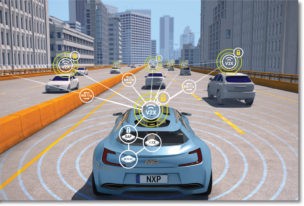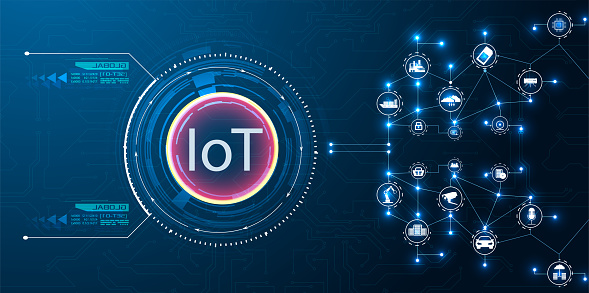Vehicle-to-everything communications, also known as V2X, is a technology that allows wireless communication between vehicles and other devices and network elements. V2X communications prolong driving safety and are the step forward for autonomous, self-driving cars. V2X supports interaction between vehicle to vehicle, between vehicle and road infrastructure and information sharing with other users and pedestrians.
Vehicle-to-vehicle (V2V) technology allows real-time wireless communication between moving vehicles, enabling the exchange of information to maintain a safe distance between cars and to avoid collisions. Vehicle-to-infrastructure (V2I) is the exchange of information between vehicles and road infrastructure components, such as traffic lights, road signs, and lane markings. Vehicle-to-pedestrians (V2P) technology enables communication between vehicles and pedestrians, whether it is just people and children or wheelchairs, children’s strollers, and other mobility devices.
V2X Communications
V2X could be developed in the form of a mesh network, where every element such as a car and smart traffic systems, could send and receive wireless signals. V2X is initially designed to use the US dedicated short-range communication (DSRC) or European Cooperative Intelligent Transport Systems (C-ITS) frequencies to transfer data.
Cellular V2X was developed by 3GPP to use the existing cellular radio LTE network and the new 5G ecosystem to enhance wireless communication further. The newly developed 5G wireless systems can offer extensive network coverage to support V2X services. The expansion of IoT, where a vast network of sensors is expected to be deployed for Smart Cities applications, including road signs and smart-traffic lights, can provide the framework on which V2X connectivity will expand, especially in urban environments.
3GPP Cellular V2X specifications
3GPP specification Technical Report 22.885 is a study on LTE support of V2X which focuses primarily on safety and non-safety features. Safety aspects revolve around pre-crash sensing, forward collision, vulnerable road user warning, and curve speed warning.
The Cooperative Adaptive Cruise Control (CACC) is developed, which is an extension to the existing adaptive cruise control concept by using sensors to reduce the delay of the human response to the preceding vehicle. Wrong way driving warning is also addressed. The system should be able to use vehicle-to-network (V2N) traffic flow optimization and provide mixed-use traffic management.
3GPP study TR 22.886 (SA1) provides enhancements on 5G NR support for 5G V2X services. The areas of focus are on automated cooperative driving for short distance grouping, and info sharing for limited or full automated platooning. Safety aspects include Cooperative Collision Avoidance (CoCA), emergency trajectory alignment, intersection safety information, and info sharing for limited or fully automated driving. Other areas such as sensor sharing, collective environment perception, and operation of a remote vehicle are also touched.
Cellular 5G V2X applications in a nutshell
Autonomous Driving: as far as autonomous driving is concerned, 5G networks can improve performance by using analytics on aggregated data to provide the required information for decision making. Remote processing and remote security may enhance overall safety by processing data and taking the necessary actions by acquiring control of vehicles with unsafe behavior. These decisions may be based on dynamic maps and sensor information regarding existing and forecasted traffic and specific road conditions.
Remote Driving: Remote driving may be similar to autonomous driving, but this time, the decisions may be taken in a virtual environment either by a remote human controller or a machine. This dynamic assistance can be provided by the cloud via centralized analytics. The system can access and control the vehicle remotely, using video streaming and sensor data to assist in specific cases such as a remote parking scenario.
Platooning: Truck platooning application will be able to link a convoy of cars/trucks and provide an automated way to control this fleet by grouping automated decisions.
Cooperative perception and assistance: This use case takes advantage of information sharing among vehicles and road infrastructure to provide a see-through or a lifted seat driver’s view to enhance road perception and safety. Furthermore, the vehicle exchange of trajectory information and centralized optimization can ensure a smooth maneuver or lane change.
Intersection assistance: vehicles that approach an intersection can share and exchange information with road infrastructure and sensors to be informed regarding incoming vehicles.
Vulnerable user warning: Vulnerable users can either be pedestrians, cyclists and motorcyclists, or even animals. The system should be able to detect these vulnerable users and be able to provide a warning to incoming vehicles. Assistance by the cloud is needed to have high accuracy positioning for vulnerable users. It is inevitable that in an area with many vulnerable users, network congestion may occur.
V2X preconditions
For V2X to become a reality, road signs should move from analog to digital, with capabilities to communicate with other devices. As mentioned above, 5G and the upcoming IoT will provide the basis for smart connectivity between vehicles and other road infrastructure.
Another precondition for a seamless quality of experience is sufficient cellular coverage of all roads. Recent developments and research on the path towards 5G, target on the improvement of communication reliability and QoS, especially when it comes down to URLLC (Ultra-Reliable Low latency Communications), multi-connectivity and network coding, or dynamic radio configuration based on context information.
Nevertheless, wireless capacity could, in some cases, be limited, and overload situations may be inevitable. The radio signal quality is heavily influenced by the continuously changing status of each automotive UE. Therefore, 5G will have to find ways to guarantee sufficient QoS for automotive safety-critical applications and acceptable end-user experience.
Most automotive applications can deal with temporary degradations of mobile communication, as long as there is early awareness and enough response time. A well and timely informed application can adapt to changes in the communication quality, for example by anticipating needed data transfers, or by switching into a mode that is less reliant on external communication. 5G SDN networks and AI data analytics may assist with this decision making.
The concept of predictive network performance and connectivity, currently targeted by some vendors, analyzes the radio propagation situation, detects and predicts degradations, and informs applications about upcoming events, thus being able to compensate to some extent the impact of degraded connection quality.
Latency is another essential factor for autonomous driving. It is expected that in the case of a high-speed moving vehicle, to avoid collision with another vehicle, the response time must be swift, either in the range of a couple of ms latency. Although collision avoidance, remote driving, and cooperative lane change require low latency, other applications such as platooning could operate in a medium latency mode.
V2X challenges
As far as V2X development is concerned, one of the main challenges is the need for extensive network coverage to support all areas. 5G connectivity is expected to compensate for network coverage. However, since 5G will not be available everywhere from day one, it is likely that autonomous driving will initially be developed in urban scenarios or specific areas such as large enterprises, airports, and highways.
Massive connectivity is also important, together with the need for digitization of the road infrastructure. The development of 5G IoT will play an essential role in connecting vehicles, road infrastructure, end-users, and sharing information from sensors and other devices.
Marketing aspects are also vital since V2X implementation depends on the investment by operators or government bodies such as Transport Ministries. There are currently V2X large-scale projects, some of which are government backed, with the collaboration of vendors and Telecom Industry operators, but autonomous driving is still at an early stage.
It may, therefore, take several years for fully automated vehicles to take on the streets and be able to have self-driving cars everywhere and under any circumstances. Regarding the time frame, it is expected to move from the current partial automation phase to conditional automation by 2020, then to high automation by mid-‘20s and finally reach full automation potentials by 2030.













